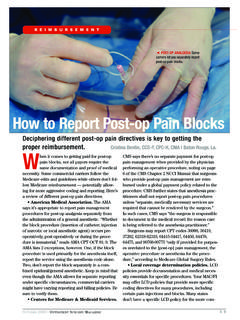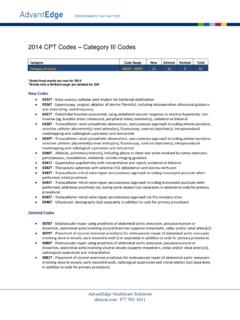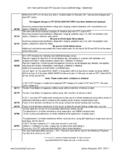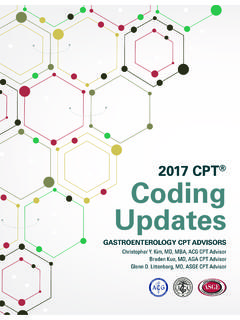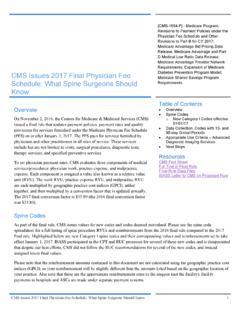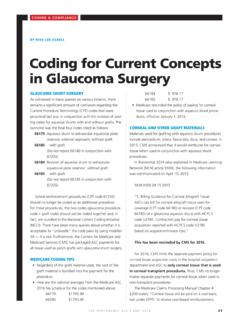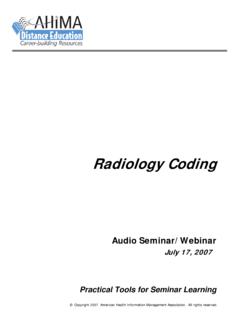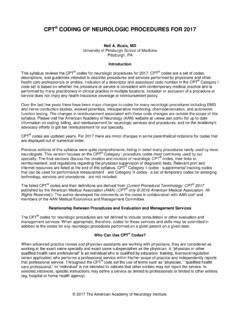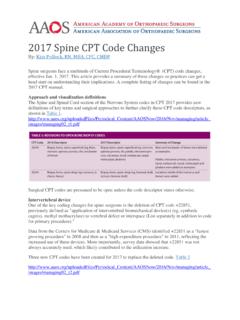Transcription of What’s New in CPT 2010? - ccmpro.com
1 40 | FOCuS January/February 2010 Changes the American Medical Association (AMA) introduced in its Current Procedural Terminology (CPT ) codes for 2010 reemphasize the need for staff education and correct coding practices at your ASC, where less than perfect documentation and coding could significantly impact your bottom line. This article provides an overview of the changes ASC coders can expect to encounter in 2010 , the Surgery section of the CPT manual has 79 new cpt codes and 95 revised codes. Almost half of the new codes are located in the Musculoskeletal System section (see the chart at the top of page 41). In addition, 23 codes previously included in the Surgery section are no longer Initiative Implemented in 2010In 2010 , the most notable change the AMA introduced in its CPT manual is a resequenc-ing initiative, or an out-of-sequence system that impacts 27 codes in the Surgery section of the manual, predominantly in the Musculoskeletal System section.
2 According to the AMA, the resequencing system was introduced to extend the existence of the current CPT number-ing system and provide flexibility of CPT content. In the past, as CPT changes occurred, certain code series were deleted and renumbered. Resequencing allows existing codes to be relocated to a new section of the manual to better accommodate the code concept, regardless of the numeric sequence in which the code numbers that fall within a family of anatomically related procedures or a subsection have been assigned whenever possible. If no code numbers within a respective section or series of codes are available, the closest code number within that section has been assigned and placed in the appropriate location. Resequenced codes are located in the sections where the user would normally find those procedures Bentin, CCS-P, CPC-H, CMA, is the founder and principal of ASC Association supporter member Coding Compliance advice and opinions expressed in this article are solely those of the author and do not represent official ASC Association policy or opinion in any s Newin CPT for 2010 ?
3 CPT copyright 2010 American Medical Association. All rights Cristina Bentin, CCS-P, CPC-H, CMA | 41 Resequenced codes are now flagged with the # symbol. Additional-ly, the CPT manual includes references at the location where the out-of-sequenced code would normally be found. These references direct users to the code series where the resequenced code can now be AMA guide CPT 2010 Professional Edition provides a Sum-mary of Resequenced cpt codes in its Appendix N. The summary cites cpt codes that do not appear in numeric sequence within the list of cpt codes in the manual. The box below contains an example of a series of resequenced codes as they would actually appear in the CPT that use electronic data systems should ensure CPT files exported for 2010 include the complete descriptions of the cpt codes .
4 Files using a truncated description with numerical sorting of the codes won t capture the complete description of the codes and could lead to reporting and billing errors. Integumentary System Adjacent Tissue TransfersFor 2010 , a revision has been made to the guidelines for adjacent tissue transfer procedures. The revised guidelines now describe the appropriate application of two new codes created to replace CPT 14300. These codes differentiate between minimal and more exten-sive adjacent tissue transfer procedures. In the 2010 CPT manual, this information appears as follows:(14300 has been deleted. To report, see 14301, 14302) 14301 Adjacent tissue transfer or rearrangement, any area; de-fect sq cm to sq cm + 14302 each additional sq cm, or part thereof (List sepa-rately in addition to code for primary procedure) ASC coders should remember that, on its own, undermining of the adjacent tissues to achieve closure does not constitute adjacent tissue transfer procedures.
5 Pending clinical documentation codes from other series may be more specific. code assignment is based on square centimeters (sq cm) that are calculated by multiplying the dimensions of the covered defect. The measurement should include the flap created to close both the primary (the excision) and secondary (the wound created by the flap) SystemWhen reviewing the 2010 changes to the cpt codes , the most substantial change can be found in the revision of soft tissue tumor 2010 CpT SuRgERY CHANgESNEWdElETEdREViSEdAuditory000 Cardiovascular826 Digestive7518 Eye000 Integumentary211 Musculoskeletal41854 Nervous1050 Reproductive103 Respiratory609 Urinary424 what s Newin CPT for 2010 ?ARC Medical, Inc4cCPT copyright 2010 American Medical Association. All rights Resequenced Codes 27327 excision, tumor, soft tissue of thigh or knee area, subcutaneous; less than 3 cm# 27337 3 cm or greater 27328 excision, tumor, soft tissue of thigh or knee area, subfascial (eg, intramuscular); less than 5 cm# 27339 5 cm or greater27329 code is out of numerical sequence.
6 See 27323 27365To order a copy of the American Medical Association s 2010 cpt codes and the companion resource CPT Changes 2010 : An Insider s View, go to | FOCuS January/February 2010codes. cpt codes have been expanded to accommodate an addition-al level of service according to the size of the will be met with 41 new and 54 revised cpt codes within the Musculoskeletal System section of the 2010 CPT manual. Eight codes that were previously available are no longer included. Many of the code changes center on the revisions or additions to the soft tissue tumor excisions, and many involve resequencing. Detailed documen-tation is key to determining code selection for soft tumor excisions as size now matters in 2010 . Gone are the days when code selection for a soft tissue tumor meant knowing if the tumor was found within the subcutaneous, deep, subfascial or intramuscular area without regard to size.
7 New code verbiage reflects size ranges for both the excision of soft tissue tumors, subcutaneous, subfascial (eg, intramuscular) and the radical resection of soft tissue tumor codes. An example of the new code verbiage appears in the box at the AMA s best effort to provide specific and concise coding guidelines for these new and revised cpt codes , contradic-tory information has surfaced. The AMA publication CPT Changes 2010 : An Insider s View uses the same guidelines for applying the soft tissue codes as the Integumentary System section of the CPT manual guidelines for lesion coding/reporting. During the AMA s CPT and RBRVS 2010 Annual Symposium, however, coding guidelines pro-vided for the excision of soft tissue tumors contradict the written publications. Physicians from the American College of Surgeons and MD Technologies4cCPT copyright 2010 American Medical Association.
8 All rights New Verbiage for Soft Tissue Tumor Excision 25075 excision, tumor, soft tissue of forearm and/or wrist area, subcutaneous; less than 3 cm # 25071 3 cm or greater 25076 excision, tumor, soft tissue of forearm and/or wrist area, subfascial (eg, intramuscular); less than 3 cm # 25073 3cm or greater the American Academy of Orthopaedic Surgeons who made presen-tations at the symposium verbally stated, The entire size of the re-section determines the code . Since users must have credible written documentation when mak-ing code selections/determinations, the AMA was asked to clarify the discrepancy between its written guidelines and the verbal clarification provided at the AMA symposium. During the symposium, presenters stated that an additional Errata will be issued during the year to clarify the AMA s position and correct the written publications.
9 Until such an additional Errata is published, ASCs should not change their coding methodology from the written guidance in the CPT SystemA parenthetical note directing users to apply modifier -52, re-duced services, to CPT 30140, Submucous resection inferior turbi-nate, partial or complete, any method, when turbinate reduction was performed has been deleted in 2010 . This change, in conjunction with revisions to cpt codes 30801 30802, is sure to resolve many questions regarding turbinate AMA revised the language in its turbinate ablation cpt codes 30801 30802 to clarify that radiofrequency ablation of the mucosa of the inferior turbinates and reduction of the turbinates are inherently included as part of the ablation procedure. Examples of these revisions follow. 30140 Submucous resection inferior turbinate, partial or complete, any method 30801 Ablation, soft tissue of inferior turbinates, unilateral or bilateral, any method ( , electrocautery, radio-frequency ablation, or tissue volume reduction); su-perficial 30802 intramural (ie, submucosal) Cardiovascular SystemCPT codes 33216 33217 now incorporate editorial revisions that reflect the number of electrodes inserted, rather than the type of device ( , single, dual, or multiple cardioverter-defibrillator).
10 For example, 33216 Insertion of a single transvenous electrode, perma-nent pacemaker or cardioverter-defibrillator 33217 Insertion of 2 transvenous electrode; permanent pacemaker or cardioverter-defibrillator 33223 Revision of skin pocket for cardioverter-defibrillator | 43 Digestive SystemAnorectal FistulaCategory III code 0170T has been deleted and elevated to a Cat-egory I CPT code as follows: 46707 Repair of anorectal fistula with plug (eg, porcine small intestine submucosa [SIS])Hemorrhoid ProceduresThe hemorrhoidectomy section of the CPT manual now includes revised language that more specifically identifies the procedure(s) than in the past. In addition, that section of the manual includes its share of resequenced codes with reference notes added where the codes would normally be found in their original numerical sequence.
